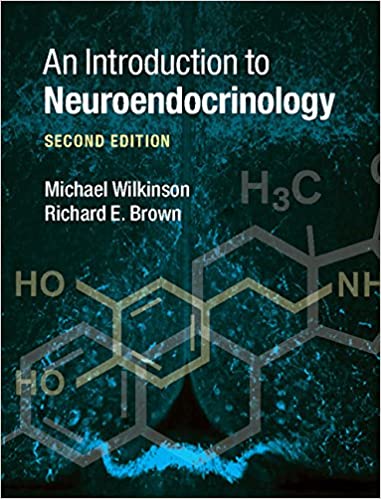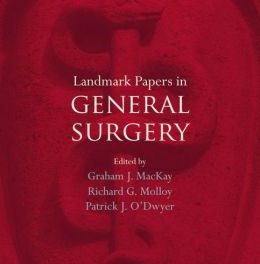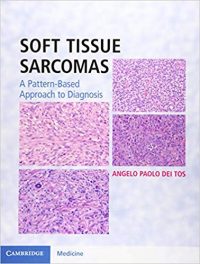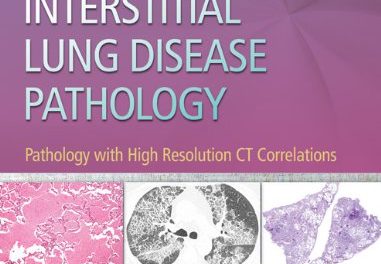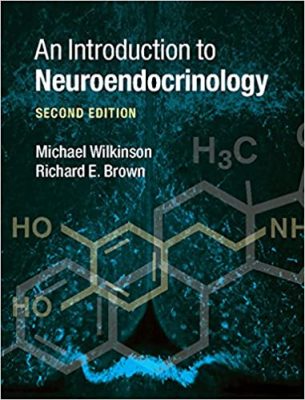 Authors: Michael Wilkinson and Richard E. Brown
Authors: Michael Wilkinson and Richard E. Brown
Publisher: Cambridge University Press – 479 pages
Book Review by: Nano Khilnani
This second edition released in 2015 contains updates as well as new data and information that have been discovered since first edition was published in 1994. As we usually do, based on what medical specialists inform us what helps them most when they read reviews, we begin our book reviews by simply providing the list of chapters (and in some cases, sections that group together the chapters) in each book. So these are the 15 chapter titles:
- Classification of chemical messengers
- The endocrine glands and their hormones
- The pituitary gland and its hormones
- The hypothalamic hormones
- Neurotransmitters
- Neurotransmitter and neuropeptide control of hypothalamic, pituitary, other hormones
- Regulation of hormone synthesis, storage, release, transport and deactivation
- Regulation of hormone levels in the bloodstream
- Steroid and thyroid hormone receptors
- Receptors for peptide hormones, neuropeptides and neurotransmitters
- Neuropeptides I : classification, synthesis and co-;localization
- Neuropeptides II: function
- Cytokines and the interaction between the neuroendocrine and immune systems
- Methods for the study of behavioral neuroendocrinology
- An overview of behavioral neuroendocrinology: present, past and future
The authors Michael Wilkinson and Richard E. Brown are both professors at Dalhousie University in Halifax, Canada. Michael Wilkinson teaches obstetrics and gynecology as well as biophysics and physiology, whereas Richard Brown has shared his discoveries and knowledge with students on hormones, learning, neurological disorders, and much more.
Wilkinson and Brown inform us that they have ‘rewritten’ but ‘greatly expanded the original content’ of their initial 1994 edition. What’s new in this 2015 edition? It includes:
- A completely new set of illustrations that are in full-color, clear, and highly detailed
- New reference lists at the end of each chapter plus useful essay and review questions
- Discussions of the many advances in neuroendocrinology from 1994 to 2015
- Modern references, but primary aim is “to provide an introductory description of mammalian neuroendocrine control systems
- Description of “basic principles necessary to understand how the brain controls, and responds to, the endocrine hormones
- Basic material that students of biology, psychology, and science can master
- Highly appropriate material as well for honors and first-year graduate students in anatomy, medicine, neuroscience, and physiology
- Content for students in two levels of classes: introductory classes wherein the material is new to students; and advanced classes wherein many terms are already familiar to those who have taken courses in biology, neuroscience, physiology, and psychology, , but have not taken any course in neuroendocrinology.
What makes this work a very good book, one that is highly valuable and usable? These features below (and many others you can discover on your own) are what make it so:
- An overall outline of the neuroendocrine system
- Vocabulary necessary to understand the interaction between hormones and the brain
- Excellent descriptions of those topics that must underpin any attempt to learn and to teach neuroendocrinology
- Readable and understandable chapters on basic neuroscience (neurotransmitters and neuropeptides), the physiology of the endocrine glands (hormones), receptors and receptor-signaling mechanisms (e.g. G proteins, nuclear receptors, hormone assay and gene-expression techniques (e.g. ELISA; in situ hybridization) and a description of the immune system, with particular emphasis on the integration of immune and the neuroendocrine pathways
- Your body weight as controlled and influence by neuropeptides is a practical topic discussed in chapter 11
- Good information is provided in this book that is essential to understand the profound effects of hormones on human behavior such as described in Chapter 14
- Obesity (faced by70 million people – 21 percent of the U.S. population, per Wikipedia) and its causes are explained on page 13 in Chapter 1
- Opioid abuse killed 47,600 people from 1999 to 2017, and 130 people die from it daily per Wikipedia. Discussion of opioids, opioid peptides is found in Chapter 11
- Dale’s Principle and the problem of co-localization. A useful re-examination of this important principle (find out why) is presented in chapter 11.
- Behavioral bioassays “require precise qualitative (verbal) descriptions of the behaviors of interest and quantitative (mathematical) measures of the latency, frequency and duration of these behaviors,” as stated in chapter 14, a very important one in this book, because it specifies the correct methods in the study of behavioral neuroendocrinology
- Ovaries in females produce estrogens, including estradiol which is very important at puberty because it is responsible for the development of female sex characteristics, for subsequent menstrual cycles and for pregnancy and human reproduction, pages 33-34.
- Oxyntomodulin, a product of the pre-proglucagon peptide, reduces food intake, and with continued treatment, helps decrease body weight, as discussed on page 307.
- Kisspeptin, a product of the Kiss 1 gene (named after the Kisses, having been discovered in a lab near that chocolate maker’s factory in Hershey, Pennsylvania) has been identified as a human metastasis suppressorgene that has the ability to suppress melanoma and breast cancer metastasis. This peptide has other uses as well – see pages 272-273 of this book
Overall, this book is worth acquiring and keeping it as an authoritative reference source,
Authors:
Michael Wilkinson has 40 years experience teaching neuroscience and neuroendocrinology to undergraduate and graduate students as a Professor in the Department of Obstetrics and Gynecology and IWK Center at Dalhousie University in Halifax Canada. His research laboratory has focused on neurodevelopment aspects of female reproduction with a specific interest in the neuroendocrine regulation of hypothalamic function, including the impact of sex hormones on sleep.
Richard E. Brown is a University Research Professor in the Department of Psychology and Neuroscience at Dalhousie University. He has taught courses on hormones and behavior, measuring behavior, and the neurobiology of learning and memory for more than 35 years. His research is on mouse models of Alzheimer’s Disease, Fragile X Syndrome, ADHD and other neurological disorders. He is currently examining the age-related hormonal changes in transgenic Alzheimer’s mice.

